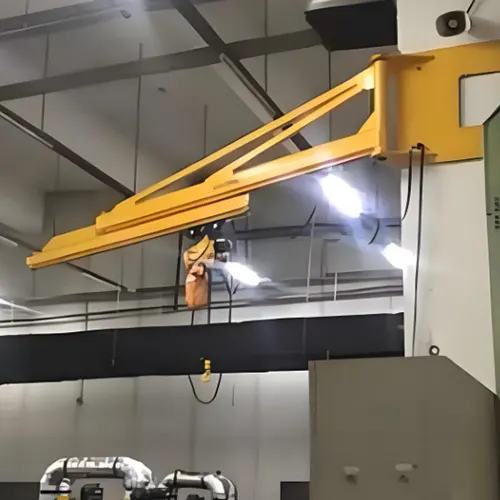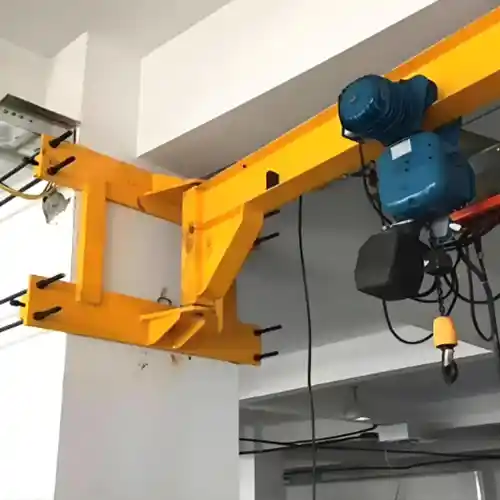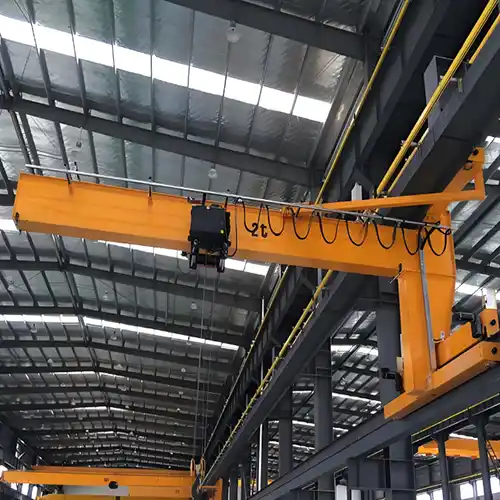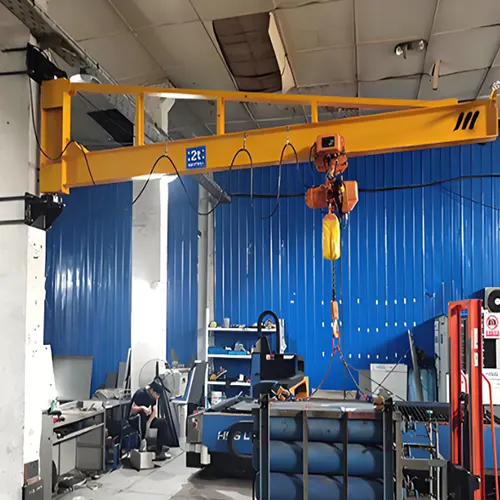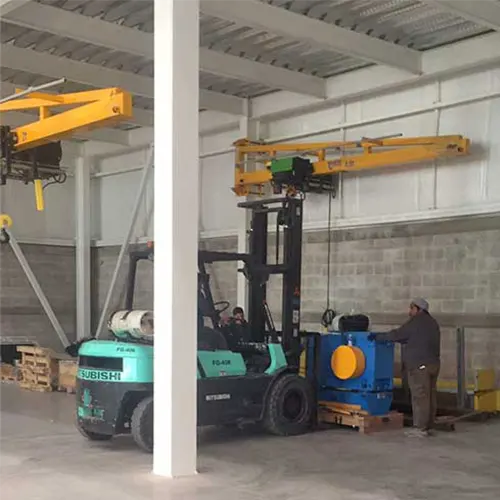Wall Bracket Jib Cranes: Cantilever vs. Tie Rod Designs 1Ton, 2 Ton, 3 Ton
Wall bracket jib cranes for sale, comparing wall cantilever and tie rod crane designs across capacities (500kg to 5 Ton) for diverse applications.
Category: Wall Crane
Your Trusted Wall Mounted Crane Manufacturer & Supplier
Wall Bracket Jib Cranes: Cantilever vs. Tie Rod Designs &Their Applications (500kg, 1 Ton, 2 Ton, 3 Ton, 5 Ton)
Wall bracket jib cranes for sale, comparing wall cantilever and tie rod crane designs across capacities (500kg to 5 Ton) for diverse applications.
Overview of Wall Bracket Jib Cranes
Definition and Purpose: Wall bracket jib cranes are versatile lifting devices mounted on walls to provide efficient overhead lifting solutions in confined spaces. These cranes are designed to move and position loads with precision, offering a practical solution for tasks that require vertical and horizontal movement. Their primary purpose is to increase operational efficiency and safety by allowing precise control over lifting and positioning operations.
Types of Wall Bracket Jib Cranes: There are two main types of wall bracket jib cranes: Cantilever and Tie Rod.
- Cantilever Wall Bracket Jib Crane: This type features a horizontal arm extending from a vertical bracket mounted on a wall. The cantilever design allows for extended reach without obstructing the area around the mounting point. It is ideal for applications requiring a wide working radius and minimal interference with other equipment or structures.
- Tie Rod Wall Bracket Jib Crane: This crane incorporates tie rods to provide additional support and stability. The tie rods connect the wall-mounted bracket to the arm, enhancing load-bearing capacity and structural integrity. This design is particularly suited for heavy-duty applications where increased strength and stability are crucial.
Importance in Various Industries
Applications in Manufacturing: In manufacturing environments, wall bracket jib cranes are used for moving components and assemblies along production lines. They facilitate tasks such as loading and unloading machines, positioning materials, and transferring parts between workstations. Their ability to handle various weights and sizes of items makes them essential for improving production efficiency and reducing manual handling.
Applications in Logistics: In logistics and warehousing, these cranes assist with the movement of goods and inventory. They are used to load and unload items from delivery trucks, reposition products within storage areas, and handle heavy or bulky items that are difficult to move manually. By enhancing the speed and accuracy of these processes, wall bracket jib cranes help streamline operations and increase productivity.
Applications in Maintenance: For maintenance tasks, wall bracket jib cranes provide support for lifting and positioning heavy equipment or parts during repairs. They are often used in service centers, factories, and other facilities where regular maintenance of machinery is required. Their precision and ease of use contribute to safer and more efficient maintenance procedures, reducing downtime and improving overall equipment reliability.

Cantilever Wall Bracket Jib Crane
Design and Structure
Key Components: The cantilever wall bracket jib crane is composed of several critical components:
- Cantilever Arm: This is the horizontal beam extending from the wall-mounted bracket. The arm supports the load and provides the primary lifting and positioning functionality.
- Wall Bracket: The bracket is securely mounted to the wall and supports the cantilever arm. It is designed to handle the forces exerted by the crane and ensure stability.
- Support Structure: This includes additional components like bearings and swivels that enable smooth movement of the arm and load. The support structure ensures that the crane can handle the operational stresses and strains.
Design Considerations: When designing a cantilever wall bracket jib crane, several factors are crucial:
- Stability: The design must ensure that the wall bracket and cantilever arm are robust enough to handle the maximum expected load without causing structural instability or failure. Reinforcements may be required depending on the load capacity and the wall material.
- Load Distribution: Proper load distribution is essential to prevent excessive stress on any single part of the crane. The design should ensure that the load is evenly spread across the cantilever arm and the wall bracket to avoid undue strain and potential damage.
Advantages of Cantilever Design
Space Efficiency and Extended Reach: The cantilever design offers significant advantages in terms of space utilization. The horizontal arm extends from the wall without requiring additional floor space, making it ideal for environments where space is limited. This design allows the crane to operate in tight areas and reach beyond obstructions, providing a greater working radius compared to other crane types.
Versatility in Mounting and Operation: Cantilever wall bracket jib cranes can be mounted on various types of walls, including concrete, steel, and masonry. This versatility in mounting makes them suitable for a wide range of environments. Additionally, the crane's ability to rotate and extend its arm enhances its operational flexibility, allowing it to handle a variety of tasks efficiently.
Applications
Typical Uses and Industry Examples: Cantilever wall bracket jib cranes are used in diverse settings:
- Manufacturing: In manufacturing facilities, these cranes are used for loading and unloading materials, transferring components between workstations, and assisting with assembly processes.
- Warehousing: In warehouses, they help with repositioning inventory, loading goods onto vehicles, and managing heavy or bulky items that need precise handling.
- Maintenance: In maintenance environments, they are employed to lift and position heavy machinery parts, facilitating repairs and routine servicing.
Benefits in Specific Environments: In specific environments, the cantilever design offers several benefits:
- Tight Spaces: In environments where floor space is constrained, the cantilever design maximizes operational area without interfering with surrounding equipment.
- Heavy Lifting: For tasks that require lifting heavy loads with extended reach, the cantilever crane's design supports efficient handling and reduces the need for manual intervention.
- Versatile Applications: Its flexibility in mounting and operation makes it suitable for various industries, from industrial plants to logistics centers, enhancing overall productivity and operational efficiency.

Tie Rod Wall Bracket Jib Crane
Design and Structure
Key Components: The tie rod wall bracket jib crane features several essential components:
- Tie Rods: These are structural elements that connect the wall bracket to the crane's arm. Tie rods provide additional support and stability, enhancing the crane's ability to handle heavy loads without compromising structural integrity.
- Wall Bracket: The bracket is anchored to the wall and serves as the base for the crane's arm and tie rods. It must be robust and securely fastened to withstand the forces transmitted by the crane.
- Mounting System: This includes the hardware and fittings used to attach the wall bracket to the wall. It ensures a secure and stable connection, allowing the crane to operate effectively.
Design Considerations: To ensure enhanced load-bearing capacity, several design factors are critical:
- Load-Bearing Capacity: The design must account for the maximum load the crane will handle. Tie rods are sized and positioned to distribute the load evenly and prevent excessive stress on any single component. Proper engineering ensures that both the wall bracket and tie rods can support the load without deformation or failure.
- Structural Integrity: The connection between the wall bracket and the tie rods must be reinforced to maintain stability under load. Design considerations include the strength of the wall material, the quality of the mounting hardware, and the overall layout of the crane components.
Advantages of Tie Rod Design
Improved Load Stability and Strength: The tie rod design significantly enhances the crane's ability to handle heavy and dynamic loads. By providing additional support through the tie rods, the crane achieves greater load stability and strength. This design minimizes the risk of bending or buckling, ensuring reliable performance even under heavy or unevenly distributed loads.
Customization Options for Different Applications: Tie rod wall bracket jib cranes can be customized to meet specific operational needs. Customization options include:
- Adjustable Tie Rods: Allow for fine-tuning the crane's load capacity and stability based on the requirements of different applications.
- Special Coatings and Materials: To protect against environmental factors such as corrosion, customization may include the use of specialized coatings or materials.
- Extended Arm Lengths: Tailoring the length of the crane's arm to suit particular tasks or spatial constraints.
Applications
Common Industries and Uses: Tie rod wall bracket jib cranes are employed in various industries for different applications:
- Heavy Industry: Used in manufacturing plants for lifting and moving heavy components, supporting assembly lines, and assisting with equipment maintenance.
- Construction: Ideal for construction sites where stability and load capacity are crucial for handling materials and tools.
- Warehouse and Logistics: Helps with the efficient movement of heavy goods and inventory, facilitating loading and unloading processes.
Specific Benefits and Examples: In specific environments, the tie rod design offers notable benefits:
- Heavy-Duty Applications: In industries requiring robust lifting solutions, the tie rod design's strength and stability make it suitable for handling substantial loads without compromising performance.
- Customized Solutions: Facilities with unique operational needs can benefit from the crane's customization options, tailoring the equipment to fit specific tasks and environmental conditions.
- Enhanced Safety: The improved stability provided by the tie rods reduces the risk of load shifting or crane failure, contributing to a safer work environment.
Overall, tie rod wall bracket jib cranes are valued for their superior load-bearing capacity and flexibility, making them a reliable choice for demanding lifting applications across various industries.
Load Capacities and Specifications

500kg Wall Bracket Jib Crane
Technical Specifications
- Load Capacity: 500kg
- Arm Length: Typically up to 3 meters
- Vertical Height: Adjustable, with common heights ranging from 2 to 4 meters
- Rotation Range: 180° to 360°, depending on the model
- Mounting Type: Wall-mounted with secure brackets and supports
Typical Applications and Industries
- Small Workshops: Ideal for handling light materials and tools in small production or repair areas.
- Laboratories: Useful for lifting and positioning equipment or supplies in research environments.
- Retail Environments: Suitable for managing inventory and stocking in smaller storage areas.
Advantages and Limitations
Advantages:- Compact size allows for use in confined spaces.
- Cost-effective solution for light lifting needs.
- Easy to install and operate in smaller facilities.
- Limited load capacity restricts use to lighter items.
- Smaller reach and height may not be sufficient for larger tasks.
- May require additional reinforcement for heavy or frequent use.

1 Ton Wall Bracket Jib Crane
Technical Specifications
- Load Capacity: 1 ton
- Arm Length: Typically up to 4 meters
- Vertical Height: Adjustable, commonly between 3 to 5 meters
- Rotation Range: 180° to 360°, adjustable based on the model
- Mounting Type: Wall-mounted with reinforced brackets and supports
Typical Applications and Industries
- Manufacturing Plants: Handling medium-weight components and assemblies on production lines.
- Warehousing: Useful for moving heavier inventory and managing storage areas.
- Maintenance Facilities: Assists in lifting and positioning equipment during repairs.
Advantages and Limitations
Advantages:- Increased load capacity compared to lighter models, suitable for medium-duty tasks.
- Versatile reach and height adjustments for varied applications.
- Reliable performance in moderate-duty settings.
- Requires stronger wall support and mounting due to increased load.
- Larger size may be less suitable for very tight spaces.
- Installation and maintenance may be more complex than lighter models.

2 Ton Wall Bracket Jib Crane
Technical Specifications
- Load Capacity: 2 tons
- Arm Length: Typically up to 5 meters
- Vertical Height: Adjustable, usually between 4 to 6 meters
- Rotation Range: 180° to 360°, based on model specifications
- Mounting Type: Wall-mounted with heavy-duty brackets and supports
Typical Applications and Industries
- Heavy Industry: Handling heavy components and machinery in manufacturing and assembly operations.
- Construction Sites: Assisting with the lifting and placement of materials and tools.
- Logistics Centers: Managing heavier goods and inventory in warehouses.
Advantages and Limitations
Advantages:
- Suitable for heavy-duty applications with significant lifting needs.
- Enhanced reach and height capabilities for larger tasks.
- Robust design ensures durability and reliable performance.
Limitations:
- Requires strong wall construction and proper installation to handle heavy loads.
- May occupy more space and require more maintenance than lighter models.
- Higher cost compared to smaller capacity cranes.

3 Ton Wall Bracket Jib Crane
Technical Specifications
- Load Capacity: 3 tons
- Arm Length: Typically up to 6 meters
- Vertical Height: Adjustable, commonly between 5 to 7 meters
- Rotation Range: 180° to 360°, adjustable depending on the model
- Mounting Type: Wall-mounted with extra-strength brackets and supports
Typical Applications and Industries
- Large Manufacturing Facilities: Moving and positioning heavy equipment and materials.
- Heavy-Duty Warehousing: Handling substantial inventory and equipment.
- Construction and Engineering: Assisting with the lifting and placement of heavy construction materials.
Advantages and Limitations
Advantages:
- High load capacity suitable for demanding industrial tasks.
- Extended reach and height for versatile applications.
- Strong design provides excellent stability and load handling.
Limitations:
- Requires extensive wall reinforcement and proper installation.
- Larger size may be cumbersome in compact spaces.
- Higher investment cost and maintenance requirements.

5 Ton Wall Bracket Jib Crane
Technical Specifications
- Load Capacity: 5 tons
- Arm Length: Typically up to 7 meters
- Vertical Height: Adjustable, often between 6 to 8 meters
- Rotation Range: 180° to 360°, model-dependent
- Mounting Type: Wall-mounted with heavy-duty, reinforced brackets and supports
Typical Applications and Industries
- Heavy Industrial Facilities: Lifting and moving very heavy components and machinery.
- Large-Scale Warehouses: Managing large volumes of heavy inventory and equipment.
- Construction and Mining: Assisting with the handling of substantial materials and tools.
Advantages and Limitations
Advantages:
- Capable of handling the heaviest loads with high stability and safety.
- Extensive reach and height for large-scale operations.
- Designed for durability and high performance in demanding environments.
Limitations:
- Requires significant wall support and specialized installation.
- Larger footprint and operational space needed.
- High cost and potential for complex maintenance needs.
This detailed overview of load capacities and specifications provides a comprehensive understanding of the different wall bracket jib cranes, their applications, and their suitability for various industrial tasks.
Features and Customization Options
Standard Features
Safety Features
- Load Limits: All wall bracket jib cranes are equipped with load limit indicators to ensure that the crane operates within its specified capacity. This feature helps prevent overloading and potential accidents.
- Emergency Stops: Most models include emergency stop buttons that allow operators to quickly halt crane operation in case of an emergency, enhancing overall safety.
- Anti-Collision Sensors: Some cranes are fitted with sensors to detect potential collisions with surrounding structures or equipment, reducing the risk of accidents.
- Overload Protection: This feature automatically prevents the crane from lifting loads beyond its maximum capacity, protecting both the equipment and the load.
Control Systems and Ease of Operation
- Manual Controls: Standard cranes often come with simple manual controls, including hand-operated levers or cranks, for basic lifting and positioning tasks.
- Electric Controls: Many models offer electric control systems that provide smooth and precise operation with buttons or joysticks, improving ease of use and efficiency.
- Remote Control: Advanced cranes may include remote control options, allowing operators to manage the crane from a distance, which can be particularly useful in larger or hazardous environments.
- User-Friendly Interface: The control systems are designed to be intuitive, with clear indicators and easy-to-use controls to facilitate smooth operation.

Customization Options
Adjustable Arm Lengths and Mounting Heights
- Arm Lengths: Cranes can be customized with adjustable arm lengths to fit specific operational needs. This flexibility allows for handling various load sizes and reaching different areas within a workspace.
- Mounting Heights: The height of the wall bracket can be adjusted to accommodate different ceiling heights or operational requirements, providing better access and versatility.
Special Coatings and Materials for Different Environments
- Corrosion-Resistant Coatings: For use in harsh environments, such as marine or chemical processing areas, cranes can be coated with anti-corrosion materials to enhance durability and extend the equipment's lifespan.
- Heat-Resistant Materials: In environments with high temperatures, cranes can be constructed from heat-resistant materials to ensure reliable performance and prevent damage.
- Custom Finishes: Various coatings and finishes can be applied to match the aesthetic or branding requirements of a facility.
Additional Safety and Operational Enhancements
- Enhanced Safety Guards: Additional safety guards can be installed to protect operators from moving parts and potential hazards.
- Load Positioning Systems: Advanced systems, such as automated load positioning or tracking, can be added to improve precision and reduce manual effort.
- Environmental Sensors: For operations in extreme conditions, sensors can be integrated to monitor environmental factors, such as temperature or humidity, ensuring the crane operates within safe limits.
These features and customization options ensure that wall bracket jib cranes are tailored to meet the specific needs of different industries and applications, enhancing safety, efficiency, and performance.
Installation and Maintenance
Installation Process
Key Steps and Requirements for Installation
- Site Assessment: Before installation, assess the site to ensure it can support the weight and load requirements of the crane. This includes evaluating the wall's structural integrity and ensuring there is adequate space for the crane's operation.
- Wall Preparation: Prepare the wall by ensuring it is clean, free of obstructions, and capable of supporting the crane's load. Reinforce the wall if necessary, based on the crane's load capacity.
- Mounting Brackets: Securely install the wall brackets using appropriate anchors and fasteners. Ensure the brackets are level and aligned to prevent any operational issues.
- Assembling the Crane: Attach the cantilever arm or tie rods to the wall brackets according to the manufacturer's instructions. Ensure all connections are secure and properly tightened.
- Alignment and Testing: Adjust the crane's arm length and height if applicable. Perform initial tests to check for proper movement and operation. Verify that the crane operates smoothly and safely.
- Final Inspection: Conduct a thorough inspection to ensure all components are installed correctly and the crane meets safety and operational standards.
Tools and Equipment Needed
- Drill and Drill Bits: For creating holes in the wall for anchors and fasteners.
- Wrenches and Screwdrivers: For tightening bolts and screws.
- Level: To ensure that the wall brackets and crane arm are properly aligned.
- Measuring Tape: For accurate measurement of arm lengths and mounting heights.
- Safety Gear: Including helmets, gloves, and eye protection, to ensure safety during installation.
Maintenance
Best Practices
- Regular Inspections: Perform routine inspections of the crane to check for wear and tear, structural integrity, and proper operation. This includes inspecting the wall brackets, tie rods, and crane arm for any signs of damage or stress.
- Lubrication: Regularly lubricate moving parts, such as bearings and joints, to ensure smooth operation and reduce friction. Follow the manufacturer's recommendations for lubrication intervals and types of lubricant.
- Servicing: Schedule periodic servicing by a qualified technician to check for any underlying issues and perform necessary repairs. Servicing may include checking load limiters, control systems, and safety features.
Common Issues and Troubleshooting Tips
- Unusual Noises: If the crane makes abnormal noises, it could indicate a problem with the bearings, gears, or other moving parts. Inspect and lubricate these components, or consult a technician if the issue persists.
- Inconsistent Movement: If the crane's arm or load movement is inconsistent, check for any obstructions, misalignments, or issues with the control system. Ensure all components are properly adjusted and functioning.
- Overloading: If the crane frequently operates near or beyond its load limit, it could cause excessive strain and potential damage. Ensure that the load is within the crane's capacity and that the load limit indicators are functioning correctly.
- Structural Damage: Regularly inspect the wall bracket and mounting system for signs of structural damage or wear. Reinforce or repair any damaged areas promptly to prevent accidents or failures.
By following these installation and maintenance guidelines, you can ensure the safe and efficient operation of wall bracket jib cranes, extending their service life and enhancing overall performance.
Cost Considerations and Pricing
Factors Affecting Cost
Load Capacity
- Higher Capacity Costs More: Generally, cranes with higher load capacities are more expensive due to the increased strength and durability required in their construction. Larger load capacities demand stronger materials, more robust design, and enhanced safety features, all of which contribute to a higher price.
- Impact on Pricing: For example, a 5-ton wall bracket jib crane will typically cost more than a 500kg crane, reflecting the greater engineering and material requirements.
Design and Customization Features
- Customization Options: Cranes with customized features, such as adjustable arm lengths, special coatings, or advanced control systems, will have higher costs compared to standard models. Customization allows the crane to meet specific operational needs or environmental conditions but adds to the overall expense.
- Design Complexity: Cranes with intricate designs, such as those with advanced safety features or specialized mounting systems, will also have higher costs due to the additional engineering and manufacturing efforts involved.
Typical Price Ranges in China
500kg Cranes
- Price Range: $1,100 to $2,100
- Factors: Lower load capacity and basic features contribute to a lower cost. Standard models without significant customization fall within this range.
1 Ton Cranes
- Price Range: $2,100 to $4,500
- Factors: Increased load capacity and potential for additional features or customization push the price higher than the 500kg models. This range includes basic to mid-range cranes with moderate customization.
2 Ton Cranes
- Price Range: $4,500 to $7,000
- Factors: Higher load capacity and possibly enhanced design elements or customization options result in a higher price. Mid-range models with specific operational needs fit within this range.
3 Ton Cranes
- Price Range: $7,000 to $11,000
- Factors: Increased load capacity, more robust design, and potential for extensive customization contribute to the higher cost. These cranes are suited for more demanding applications.
5 Ton Cranes
- Price Range: $11,000 to $17,000
- Factors: The highest load capacity, combined with advanced features and possible customizations, leads to the highest price range. These cranes are designed for heavy-duty industrial applications and often include significant customization.
Cost Comparison with Other Crane Types
- Overhead Cranes: Overhead cranes generally have higher costs than wall bracket jib cranes due to their larger size, complex design, and greater load capacities. Prices for overhead cranes in China can range from $21,000 to $85,000, depending on capacity and features.
- Gantry Cranes: Gantry cranes also tend to be more expensive than wall bracket jib cranes, particularly for large-capacity models. Costs can vary widely from $15,000 to $45,000, depending on size and specifications.
- Jib Cranes: Compared to tie rod wall bracket jib cranes, other types of jib cranes (such as pillar-mounted or floor-mounted models) may have higher costs due to different mounting requirements and design complexities. Prices for these cranes can range from $7,000 to $21,000, depending on the design and load capacity.
Overall, wall bracket jib cranes offer a cost-effective solution in China for various lifting needs, with prices varying based on load capacity and customization features. Evaluating both the initial cost and the long-term benefits is important to ensure the best fit for your operational requirements and budget.
Case Studies and Applications
Case Study 1: Cantilever Wall Bracket Jib Crane (500kg)
Industry and Application
- Industry: Small manufacturing and assembly operations.
- Application: Used for lifting and positioning light components and tools in a compact workshop setting.
Benefits Observed
- Space Efficiency: The cantilever design allows for use in tight spaces, freeing up floor area for other activities.
- Ease of Use: Operators can easily maneuver lightweight items, improving workflow and reducing manual handling.
- Cost-Effective: The lower load capacity and simple design make it an economical choice for small-scale operations.
Case Study 2: Tie Rod Wall Bracket Jib Crane (1 Ton)
Industry and Application
- Industry: Automotive parts manufacturing.
- Application: Employed for handling medium-weight engine components and assembly tools in an automotive assembly line.
Benefits Observed
- Improved Load Stability: The tie rod design enhances stability and minimizes sway, which is crucial for precise component handling.
- Customization: Adaptable to various mounting heights and arm lengths, accommodating different operational needs.
- Enhanced Durability: Robust construction supports frequent use and heavy lifting, contributing to long-term reliability.
Case Study 3: Cantilever Wall Bracket Jib Crane (2 Ton)
Industry and Application
- Industry: Metalworking and fabrication.
- Application: Used for lifting and transporting medium-sized metal parts and tools within a fabrication shop.
Benefits Observed
- Extended Reach: The cantilever design provides extended reach over the work area, facilitating easier access to hard-to-reach spots.
- Versatility: Can be mounted in various positions, allowing for flexible use in different parts of the workshop.
- Efficiency: Streamlines the handling of metal parts, reducing time and effort required for manual lifting.
Case Study 4: Tie Rod Wall Bracket Jib Crane (3 Ton)
Industry and Application
- Industry: Heavy machinery maintenance.
- Application: Utilized for lifting and moving large machine parts and equipment components in a maintenance facility.
Benefits Observed
- Enhanced Load-Bearing Capacity: The tie rod structure supports heavier loads with increased stability, crucial for handling large components.
- Customizability: The crane's design can be tailored to fit specific maintenance tasks and operational constraints.
- Safety: Improved safety features reduce the risk of accidents during heavy lifting operations.
Case Study 5: Cantilever Wall Bracket Jib Crane (5 Ton)
Industry and Application
- Industry: Industrial warehousing and logistics.
- Application: Employed for handling large and heavy items, such as pallets and storage containers, in a warehouse environment.
Benefits Observed
- High Capacity: The 5-ton capacity accommodates substantial lifting needs, making it suitable for heavy-duty tasks.
- Space Optimization: The cantilever design allows for efficient use of space within the warehouse, improving overall workflow.
- Operational Efficiency: Increases efficiency in moving and managing large items, reducing manual labor and operational time.
These case studies illustrate the diverse applications and benefits of wall bracket jib cranes in various industries. Each crane type and capacity is chosen based on specific operational needs, showcasing the adaptability and efficiency of these lifting solutions.
Conclusion
Advantages of Cantilever vs. Tie Rod Wall Bracket Jib Cranes
- Cantilever Wall Bracket Jib Cranes: These cranes are known for their space efficiency and extended reach, making them ideal for environments where floor space is limited. They offer versatility in mounting and operation, which enhances their usability in various settings, such as small workshops and light manufacturing environments.
- Tie Rod Wall Bracket Jib Cranes: Tie rod cranes excel in load stability and strength, making them suitable for handling heavier loads and providing enhanced durability. The tie rod design allows for customization in mounting heights and arm lengths, which is beneficial for applications requiring precise lifting and stability, such as automotive assembly lines and heavy machinery maintenance.
Ideal Applications for Different Capacities
- 500kg Cranes: Best suited for small-scale operations where space is at a premium and only light components need to be lifted. Ideal for compact workshops and assembly tasks.
- 1 Ton Cranes: Suitable for medium-weight tasks in industries such as automotive parts manufacturing. These cranes offer a good balance between capacity and flexibility, making them versatile for various medium-duty applications.
- 2 Ton Cranes: Effective for handling medium-sized metal parts in metalworking and fabrication environments. Their extended reach and versatility support efficient workflow and handling of moderately heavy items.
- 3 Ton Cranes: Well-suited for heavy machinery maintenance and other applications requiring higher load-bearing capacity and stability. These cranes provide robust support for large components and equipment.
- 5 Ton Cranes: Ideal for industrial warehousing and logistics where heavy lifting and large item handling are required. Their high capacity and space optimization capabilities enhance operational efficiency in large-scale environments.
Final Recommendations
Selecting the Right Crane for Specific Needs: Choosing the appropriate wall bracket jib crane involves assessing your specific operational requirements, including load capacity, space constraints, and desired features. Consider the following:
- Capacity Needs: Select a crane with a load capacity that matches your lifting requirements to ensure safe and efficient operations.
- Space Availability: Evaluate whether a cantilever or tie rod design best fits your workspace constraints and operational needs.
- Customization Requirements: Determine if you need additional customization features, such as adjustable arm lengths or special coatings, to address specific operational or environmental conditions.
In summary, wall bracket jib cranes offer diverse and adaptable solutions for various lifting needs. By considering the advantages of different designs and capacities, you can select the right crane to enhance operational efficiency and meet specific application requirements. Keeping an eye on future trends will help ensure that you benefit from the latest advancements in crane technology.
Main Projects
Related Products

Supplied three grab bucket crane kits to Indonesia, enhancing garbage handling efficiency with high load capacity and reliable performance.
Free consultation to Confirm Parameters & Specifications and Get
Latest Crane Price & Crane Rate.
- Types of overhead cranes : _______?
- Optional: Overhead travelling crane, goliath gantry crane,Slewing jib crane, Single girder or double girder crane,small portable crane or kbk crane, etc.
- Capacity of overhead crane: _______?
- Optional: 0.25ton, 0.5 ton, 1 ton, 2 ton, 3ton, 5 ton, 10 ton,15ton, 20ton, 25 ton, 30ton,35ton, up to 550ton, etc.
- Crane span & lifting height : _______?
- Crane travelling length : _____?
- Control of overhead crane:_______?
- Optional: pendant/ remote/cabin control
- Voltage supply of overhead crane:_____?
- Eg,: 380V50/60HZ,3Phase or others,etc.
- Application/usage of crane:_______?
- Eg,: Steel mill, ,injection mold, cement,stone, concrete,granite, general manufacturing, etc.
Just leave a message via the contact form and our hoist and crane engineer will contact you with in 24working hours.
Get In Touch
